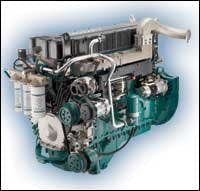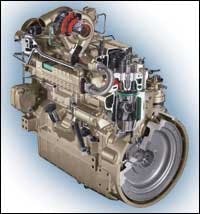Although we didn't specifically ask the question in recent conversations with a number of companies that build off-road diesel engines, we're pretty sure that none uses a crystal ball to help bring off-road diesel engines into exhaust-emissions compliance. But they might be tempted, considering the difficult challenge of continuing to reduce two stubborn pollutants in diesel exhaust — particulate matter (PM) and oxides of nitrogen (NOx) — that concern clean-air regulators worldwide.
Standards for regulating exhaust emissions from off-road diesels, as you may know, are being phased in over an approximate 20-year period, which began in 1996 and will conclude, as it stands now, in 2015. The process is divided into five Tiers — 1, 2, 3, 4-Interim and 4-Final. The implementation of the various Tiers is staggered, based on horsepower ratings, but between January 2005 and January 2008, off-road diesels from 49 to 751 horsepower must become Tier-3 compliant.
Generally, Tier-3 standards for this large group of engines require an approximate reduction in NOx of 40 percent from Tier-2 levels, while PM levels remain essentially the same. The specific technology being applied to reach Tier-3 compliance differs, not only from manufacturer to manufacturer, but also within a manufacturer's own line in order to satisfy the divergent needs of engine-using customers.
Tier-3 standards, generally speaking, have forced nearly a 60-percent reduction in NOx from 1996 levels, and an approximate 65-percent reduction in PM. But consider this: Tier-4-Final standards for a large group of engines used in construction machines will require reductions in PM and NOx on the order of about 90 percent from Tier-3 levels.
Without minimizing the hard work and technical innovation required to attain Tier-3 compliance, the looming Tier-4 standards seem to be the toughest nut yet to crack. Tier-4-Interim standards, which will take effect for a large group of engines in 2011 and 2012, require a 10-fold reduction in PM, along with a two-fold drop in NOx. Tier-4-Final standards, which will follow in 2014 and 2015, require yet another five-fold decrease in NOx.
Doug Laudick, product manager at John Deere Power Systems, sums up the basic challenge for engine makers as they continue to bring cleaner engines to market:
"If you look at all our customers," says Laudick, "including our own John Deere factories, there are two things they want — performance that meets or exceeds the previous tier, and fuel economy that meets or exceeds the previous tier. They don't want to sacrifice either one."
Satisfying those basic customer expectations, however, is complicated by economics, says Laudick. Some customers are willing to pay more for high performance, while others are quite cost-sensitive and want the lowest price — but without trading all that much performance.
Using John Deere Power Systems as an example of how manufacturers walk this tight wire, the company approached Tier-3 compliance from several directions. Its premium Power Tech Plus engines, for instance, with displacements of 13.5, 9.0, 6.8 and 4.5 liters, use four-valve heads, cooled EGR (exhaust-gas recirculation), variable-geometry turbochargers (for more precise combustion-air management) and a new electronic control module.
For more cost-sensitive markets, 2.4-, 3.0-, 4.5- and 6.8-liter engines also are available as Power Tech "E" models, with two-valve heads; full-authority electronic controls; standard or waste-gate turbocharger (depending on displacement); common-rail or electronic-unit-pump fuel system; and air-to-air aftercooling. And as a third alternative, some versions of the 2.4- and 4.5-liter engines have mechanical fuel system options.
Komatsu also has a varied approach to meeting Tier-3 standards for its off-highway engines, which range in displacement from 3 to 78 liters. The company's "ecot3" (ecology and economy for Tier 3) emissions-control strategies are "based upon providing emissions reductions, improved fuel economy and overall performance in the particular engine and machine application."
All Tier-3 Komatsu engines do, however, use common-rail fuel systems, electronic control systems and air-to-air charge-air cooling. In addition, says the company, its patented combustion system is used in certain applications, as is cooled EGR on larger engines.
At Cummins, says Wayne Eckerle, executive director of research and technology, the company's overall design philosophy is to develop a range of technical solutions to meet the varying needs of engine customers, then to choose those most appropriate for the application. Cummins' basic approach to Tier-3, he says, was "sub-system optimization and system integration," which was accomplished largely with the company's "analysis-led" design process.
This process uses powerful software to analyze the combustion process by investigating a vast number of permutations involving fuel delivery, air management, electronic control and the physical design of system components. The engineer can then choose the optimum "recipe" for effective control based on application.
Using this approach, says Eckerle, Cummins has attained Tier-3 compliance for its off-road engines solely with "in-cylinder" techniques and, thus, the use of cooled EGR and variable-geometry turbochargers has not been required.
Volvo Construction Equipment has recently developed a new generation of Tier-3-compliant, heavy-duty engines, ranging in displacement from 9 to 16 liters, which are designed with the company's V-ACT (Volvo Advanced Combustion Technology) system. V-ACT, which also will be applied in similar fashion to a new range of medium-duty Volvo engines, consists of a number of emission-control techniques.
Included in the V-ACT arsenal, says the company, are new fixed-geometry turbochargers with improved flow characteristics, new fuel-injection system with high-pressure capability, new camshafts, a patented "switchable" internal exhaust-gas-recirculation system (I-EGR), an enhanced engine electronic control unit (E-ECU), new charge-air coolers and new radiators.
Caterpillar's approach for controlling off-road-diesel emissions is essentially borrowed from technology developed for its on-highway diesels — ACERT (Advanced Combustion Emission Reduction Technology). According to Caterpillar, company engineers worked with approximately 125 variables and more than 10 million possible combustion combinations to find the "optimum balance of reduced emissions, engine performance, fuel efficiency and engine durability."
Depending on the specific application, the fuel system employed in the ACERT approach is either a Cat common-rail system or electronic unit injectors (either hydraulic or mechanical). Included in ACERT's air-management system are cylinder heads that provide unencumbered airflow to the cylinders, and waste-gate turbochargers. Electronic control for ACERT engines is provided by the company's ADEM A4 electronic control module. Tier-3 off-road diesels with ACERT technology, however, do not use an aftertreatment device in the exhaust stream (an oxidation catalyst) as do their on-highway counterparts.
In general, packaging Tier-3 engines into vehicles likely will create few problems, but may require a larger or better-managed cooling system to handle higher heat rejection. Fuel economy in Tier-3 engines, again generally speaking, is on par with Tier 2.
For some engines, replacing a Tier-2 mechanical fuel system with an electronic system may boost fuel economy. On the other hand, a well-tuned Tier-2 engine already using electronic control may take a slight fuel-economy hit. But not in every instance; at least one manufacturer reports fuel improvements ranging from 1 to 6 percent on engines already using electronic fuel systems, but now also incorporating cooled EGR and variable-geometry turbochargers.
According to Cummins' Eckerle, the common-rail fuel system continues to be a huge help when developing emissions-control solutions that preserve fuel economy. The system, which uses a separate pump to maintain fuel pressure via an accumulator, has two primary advantages, he says, namely, injection pressure is independent of engine speed, and fuel can be delivered to the cylinder in multiple pulses.
Multiple-pulse fuel injection (delivering the fuel for a single "combustion event" in sequential phases) has become an effective technique for emissions control. In addition, says Eckerle, the technique can make an engine more sociable by significantly reducing combustion noise. In the future, he says, common-rail systems may be refined with a "closed-loop" technology, which uses sensors to report what actually occurred during a combustion event, and then processes this data to further fine-tune combustion.
Although manufacturers are still investigating all possible alternatives for complying with Tier-4 standards, cooled-EGR and after-treatment seem at this point, at least, to be among the most practical for most manufacturers. After-treatment devices are positioned in the vehicle's exhaust piping and designed to reduce PM and NOx that escape the best efforts of in-cylinder techniques.
Xinqun Gui, manager of engine technology for John Deere Power Systems, believes that the significant drop in PM for Tier-4-Interim likely will force after-treatment in the form of a particulate trap. The trap will catch and hold particulates in the exhaust; then, typically with the help of a catalyst, will "self-regenerate" (burn away collected soot) if exhaust temperatures of 300C are attained during at least 30 percent of the engine's running time.
If exhaust temperatures are insufficient for self-regeneration, a forced-regeneration system with appropriate controls will be required. What will not burn in the trap, however, is ash residue from the engine oil, which means, says Cummins' Eckerle, that the trap either must be sized to accommodate a lifetime of ash or, if smaller in size, must be "shaken out" periodically.
Attaining the NOx level for Tier-4-Interim also may require after-treatment but, says Gui, "there are technologies that may provide NOx control without it. These include more sophisticated EGR systems, changes in fuel strategy and more refined turbochargers." Both Gui and Eckerle agree, though, that getting to the Tier-4-Final NOx level, at the PM level required, may require NOx after-treatment.
Briefly, three basic types of NOx after-treatment are under consideration: the lean-NOx catalyst; lean-NOx trap, also called a NOx adsorber; and selective catalytic reduction (SCR). All of these devices use a catalyzed trap to hold NOx until regeneration takes place, and the regeneration process is essentially what differentiates the three.
The lean-NOx catalyst will regenerate with the addition of hydrocarbons in an oxygen-rich exhaust stream, but the NOx adsorber, although more effective, must be regenerated in an oxygen-deficient environment, thus requiring more sophisticated controls. The SCR device has a control system that continually injects an aqueous solution of ammonia (urea) for regeneration, and is generally used with a diesel oxidation catalyst to deal with "ammonia slip" — ammonia that escapes from the trap.
Both Eckerle and Gui agree, however, that a combustion technique that has been "kicking around for 25 years" (says Eckerle) may hold great potential for accomplishing much of Tier-4 PM and NOx control in-cylinder. The technique, homogeneous charge compression ignition (HCCI), is a technique for thoroughly premixing the fuel/air charge before it burns.
"If you can do this," says Eckerle, "you can operate at a very low NOx level. But it's a very difficult combustion event to control, and operating in a pure HCCI mode across the entire engine map is tough to accomplish. But, there are ways to achieve a less-than-perfect HCCI...and if you can tame this kind of combustion, then levels for Tier 4 are achievable in-cylinder."
According to Deere's Gui, even though the combustion process in today's diesels has become extremely efficient and is measured in milliseconds, the combustion event typically is still long enough — and temperatures high enough — to promote the formation of NOx and PM. But combustion of a very uniform fuel/air mixture occurs so rapidly, by comparison, that its duration and temperature are such that the production of NOx and PM is substantially diminished.
"The technical barrier for HCCI," says Gui, "is control — making sure that each cylinder does the same thing and that each cycle of the same cylinder is consistent. This becomes the real challenge, yet HCCI offers the possibility of getting the engine's NOx level down to a point that potential NOx after-treatment systems could be vastly simplified."
And one more bit of technology that may be on the horizon — engine "electrification." Both Eckerle and Gui noted that the U.S. Department of Energy is working with engine manufacturers to capture unused energy from diesel fuel that goes up the exhaust stack as heat. Thermal generators, driven by exhaust heat, much like a turbocharger, could generate electricity.
That electricity could be used, says Eckerle, to drive accessories — water pumps, fans, hydraulic pumps and the like — to reduce parasitic loads on the engine. Or, says Gui, the electrical power generated also could be directed back into the crankshaft, assisting rotation, and thus easing the load on the engine's combustion system. Electrification of an engine, says Eckerle, could mean that a smaller engine could do the same work, or that the same-size engine could do more work. Either way, less fuel is used per unit of work, and the task of controlling emissions is mitigated.






